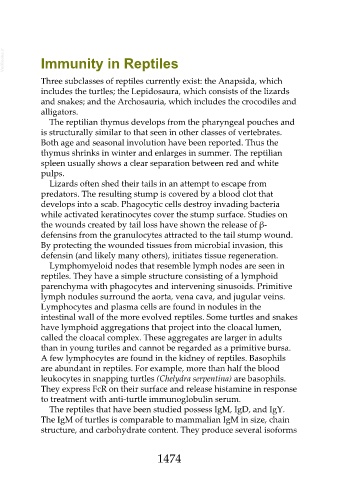Page 1474 - Veterinary Immunology, 10th Edition
P. 1474
VetBooks.ir Immunity in Reptiles
Three subclasses of reptiles currently exist: the Anapsida, which
includes the turtles; the Lepidosaura, which consists of the lizards
and snakes; and the Archosauria, which includes the crocodiles and
alligators.
The reptilian thymus develops from the pharyngeal pouches and
is structurally similar to that seen in other classes of vertebrates.
Both age and seasonal involution have been reported. Thus the
thymus shrinks in winter and enlarges in summer. The reptilian
spleen usually shows a clear separation between red and white
pulps.
Lizards often shed their tails in an attempt to escape from
predators. The resulting stump is covered by a blood clot that
develops into a scab. Phagocytic cells destroy invading bacteria
while activated keratinocytes cover the stump surface. Studies on
the wounds created by tail loss have shown the release of β-
defensins from the granulocytes attracted to the tail stump wound.
By protecting the wounded tissues from microbial invasion, this
defensin (and likely many others), initiates tissue regeneration.
Lymphomyeloid nodes that resemble lymph nodes are seen in
reptiles. They have a simple structure consisting of a lymphoid
parenchyma with phagocytes and intervening sinusoids. Primitive
lymph nodules surround the aorta, vena cava, and jugular veins.
Lymphocytes and plasma cells are found in nodules in the
intestinal wall of the more evolved reptiles. Some turtles and snakes
have lymphoid aggregations that project into the cloacal lumen,
called the cloacal complex. These aggregates are larger in adults
than in young turtles and cannot be regarded as a primitive bursa.
A few lymphocytes are found in the kidney of reptiles. Basophils
are abundant in reptiles. For example, more than half the blood
leukocytes in snapping turtles (Chelydra serpentina) are basophils.
They express FcR on their surface and release histamine in response
to treatment with anti-turtle immunoglobulin serum.
The reptiles that have been studied possess IgM, IgD, and IgY.
The IgM of turtles is comparable to mammalian IgM in size, chain
structure, and carbohydrate content. They produce several isoforms
1474

